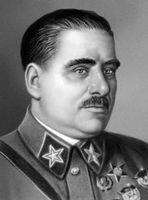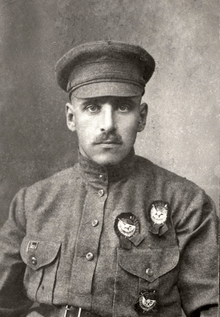Vasily Blyukher
| Vasily Blyukher | |
|---|---|
 Marshal of the Soviet Union Vasily Blyukher . | |
| Birth name | Vasily Konstantinovich Gurov |
| Born |
December 1, 1889 Barschinka, Russian Empire |
| Died |
November 9, 1938 (aged 48) Moscow, Soviet Union |
| Buried at | Donskoi Cemetery |
| Allegiance |
(1914 — 1915) (1917—1938) |
| Service/branch |
|
| Years of service | 1914—15; 1917—38 |
| Rank | Marshal of the Soviet Union |
| Commands held |
|
| Battles/wars |
World War I Russian Civil War Sino-Soviet conflict Battle of Lake Khasan Soviet–Japanese border conflicts |
| Awards |
Order of Lenin (2) Order of the Red Banner (4) Order of the Red Star |
_and_Mongolia.tif.jpg)
Vasily Konstantinovich Blyukher (also spelled Bliukher, Blücher, etc., (Russian: Васи́лий Константи́нович Блю́хер; December 1 [O.S. November 19] 1889 – November 9, 1938) was a Soviet military commander.
Early history
Blyukher was born into a Russian peasant family called Gurov in village of Barschinka, in Yaroslavl Governorate. In the 19th-century, a landlord gave the nickname Blyukher to the Gurov family in commemoration of the famous Prussian Marshal Gebhard Leberecht von Blücher (1742-1819). A factory worker before World War I, Vasily Gurov – who later formally assumed Blyukher as his surname – joined the army of the Russian Empire in 1914 and served as a corporal until discharged in 1915 after being seriously wounded in the Great Retreat of that year.[1] In 1916 he joined the Russian Social Democratic Labour Party. He took part in the Russian Revolution of 1917 in Samara.[2]
Civil War
In late November 1917 he was sent into Chelyabinsk to suppress Alexander Dutov's revolt as Red Guard commissar. Blyukher joined the Red Army in 1918 and was soon a commander. During the Russian Civil War he was one of the outstanding figures on the Bolshevik side. After the Czech Legion Revolt started, in August–September 1918 the 10,000-strong South Urals Partisan Army under Blyukher's command marched 1,500 km in 40 days of continuous fighting to attack the White forces from the rear, then join with regular Red Army units. For this achievement, in September 1918 he became the first recipient of the Order of the Red Banner (later he was awarded it four more times: twice in 1921 and twice in 1928),[2] his citation saying: "The raid made by Comrade Blyukher forces under impossible conditions can only be equated with Suvorov's crossings in Switzerland." After the force rejoined the Red Army lines in the 3rd Red Army area, Blyukher's force was reorganised as the 51st Rifle Division, which he later led to further triumphs against Baron Wrangel in November 1920.
Far East command
After the Civil War, he served as military commander of the Far Eastern Republic in 1921-1922. From 1924 to 1927 Blyukher was a Soviet military adviser in China, where he used the name Galen[3] (after the name of his wife, Galina) while attached to Chiang Kai-shek's military headquarters. He was responsible for the military planning of the Northern Expedition which began the Kuomintang unification of China. Among those he instructed in this period was Lin Biao, later a leading figure in the Chinese People's Liberation Army. Chiang allowed Blyukher to "escape" after his anti communist purge.[4] On his return he was given command of the Ukraine military district, and then in 1929 he was transferred to the vitally important military command in the Far Eastern Military District, known as the Separate Red Banner Far Eastern Army (OKDVA).
Based at Khabarovsk, Blyukher exercised a degree of autonomy in the Far East unusual for a Soviet military commander. With Japan steadily extending its grip on China and hostile to the Soviet Union, the Far East was an active military command. In the Russo-Chinese Chinese Eastern Railroad War of 1929-1930 he defeated the Chinese warlord forces in a quick campaign. For this outstanding achievement he became the first recipient of the Order of the Red Star in September 1930.[2] In 1935 he was made a Marshal of the Soviet Union. In July and August 1938 he commanded the Soviet Far East Front in a less decisive action against the Japanese at the Battle of Lake Khasan, on the border between the Soviet Union and Japanese-occupied Korea.
Soviet Purges and death
The importance of the Far East Front gave Blyukher a certain degree of immunity from Stalin's purge of Red Army command, which had begun in 1937 with the execution of Mikhail Tukhachevsky. In fact, Blyukher had been a member of the tribunal that convicted Tukhachevsky. In 1938 he was accused of inadequate armed forces leadership during the battle of Lake Khasan and dismissed from his post. On October 22 he was arrested, convicted of espionage for Japan.[2] A contributory factor in Blyukher's downfall was the defection to Japan in June 1938 of the NKVD chief in the Far East, Genrikh Lyushkov, who feared arrest.
In prison Blyukher refused to confess and was never formally tried.[5] He was severely tortured in Lefortovo jail in Moscow,[2] which according to one source led to his death on November 9, 1938,[6] though another says he was shot on Joseph Stalin's orders.[7] When people began to ask about his whereabouts they were told that he was fighting in China under a pseudonym.[7] His death was officially confirmed in 1956 when he was posthumously rehabilitated.[2] In 1939, Chiang inquired about Blyukher's whereabouts in a meeting with Stalin, and asked if he could return to help the Nationalists. Stalin replied that the General had been executed for helping a Japanese spy.[8]
He continues to be a popular figure in Russia, and a documentary film on his life and several publications by family members have appeared.[9]
Honours and awards

- Two Orders of Lenin (1931, 1938)
- Order of Red Banner of RSFSR, three times
- Resolution of the Central Executive Committee on 30 September 1918, presented 11 May 1919 by the Special Representative at the headquarters of the Central Executive Committee of the 3rd Army on the Eastern Front;
- Order 197 of 14 June 1921 - for the battles on the Eastern Front, the 30th Infantry Division;
- Order 221 of RVSR, 20 June 1921 - for the assault on Perekop at the Perekop Isthmus by 51st Infantry Division;
- Order of Red Banner of the USSR, twice
- Order RVS USSR 664 of 25 October 1928 - for the defence of the Kakhovka bridgehead;
- Order RVS USSR 101 1928 - in commemoration of the 10th anniversary of the Red Army;
- Order of the Red Star(1930)
- Jubilee Medal "XX Years of the Workers' and Peasants' Red Army" (1938)
- Badge "5 years of the Cheka-GPU" (1932)
- Cross of St. George, 3rd and 4th classes
- Medal of St. George
References
- ↑ W. Bruce Lincoln, Red Victory: A History of the Russian Civil War (Da Capo: 1999, repr. of Simon & Schuster, 1989), p. 443.
- 1 2 3 4 5 6 Great Russian Encyclopedia (2005), Moscow: Bol'shaya Rossiyskaya enciklopediya Publisher, vol. 3, p. 618.
- ↑ Adam Krzyżanowski. Raj doczesny komunistów. Arcana, Kraków 2008, p. 269. ISBN 978-83-60940-24-2
- ↑ "Generalissimo and Madame Chiang Kai-shek". TIME. Jan 3, 1938. Retrieved May 22, 2011.
- ↑ Dmitri Volkogonov, Triumph and tragedy, 1989, page 242
- ↑ Блюхер Василий Константинович
- 1 2 Roy Medvedev, Let History Judge, 1971
- ↑ Jonathan Fenby, The Penguin History of Modern China, 2008, page 190
- ↑ http://www.alacona.com/productimages/auto65.html